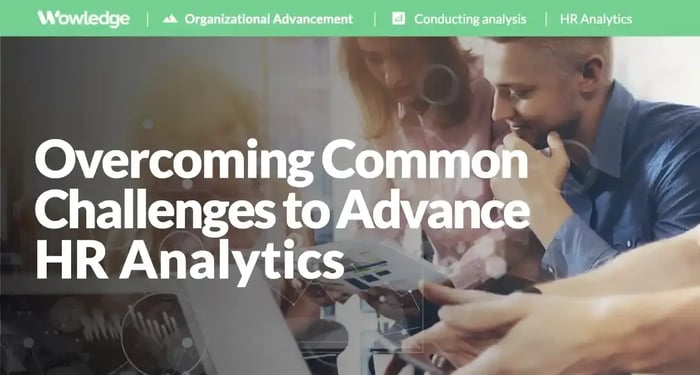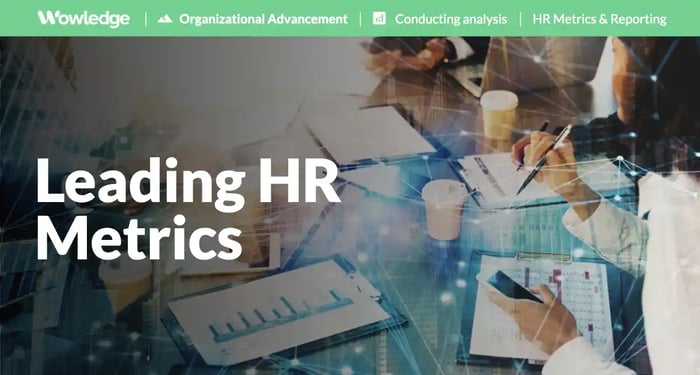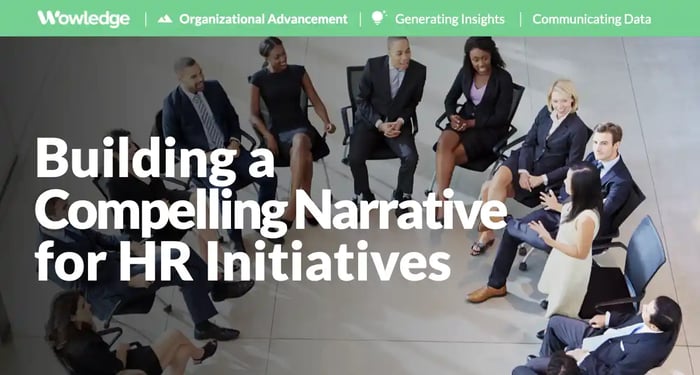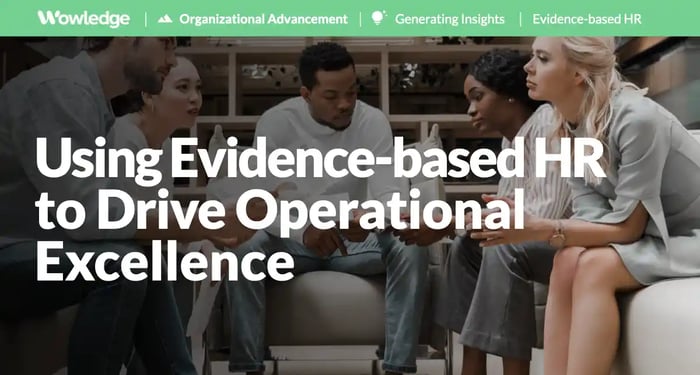Table of Contents
- Why HR analytics continues to fall short in organizations
- Action steps to take to overcome challenges with HR analytics
- 1. Understand strategic business needs and translate those into HR metrics
- 2. Identify critical audiences and tailor metrics and reporting to their unique needs
- 3. Leverage multiple systems and sources to produce integrated metrics
- 4. Measure outcomes vs. processes to increase business insights and impact
- 5. Create a dedicated analytics team to "own", manage, and evolve HR analytics capabilities
- 6. Train HR Staff members to leverage data and analysis capabilities
- 7. Communicate, evaluate, and update
- Creating a core focus on business and talent outcomes
- Relevant Practices & Tools
- FAQs
-
There have been some recent posts and articles related to advancing HR Analytics that have grabbed our attention, especially those that propose focusing on maturing these capabilities to bring greater objectivity and impact to the businesses they help manage. What strikes us are two things in particular—first, that we in Human Resources have been talking about this for decades, and second, that combined or integrated business and HR metrics have been available but difficult for organizations to access for years.
As frustrating as it seems, while many of the necessary technologies have been in place and the pundits have said “now is the time” for many years, the reality is that combining and accessing the data using those systems has never been as easy as it appeared. Basic issues continue to haunt corporate efforts to create a robust and informative capability, with a lack of data dictionaries, agreement, and alignment regarding calculation methods, restricted or difficult access to necessary datasets, poorly integrated systems, and continuing issues with HR quantitative skill levels. These are serious challenges to advancing HR analytics.
One recent post by Dave Ulrich suggests a maturity model-style evolution that starts with Benchmarking and progresses through Best Practice to Predictive Analytics up to Guidance, which focuses on generating tailored insights into stakeholder impact and drivers of desired results. What is appealing about this is that it assumes that basic HR metrics are in place and can be leveraged for more robust cause-and-effect analyses that integrate HR practices, programs, and initiatives with customer, financial, community, and talent outcomes. While many organizations aspire towards entering the latter stages of maturity, the struggles are holding them back. The model is not the newest proposition, but it is one that focuses the HR community’s attention on the application of advanced statistics to integrated business and HR data.
Another article by Josh Bersin discusses thinking on what he terms “Systemic People Analytics”, or the merging of “people data” with business data and connected HR analytics. In essence, he argues that companies continue to struggle to get quality data and analyses that provide useful insights to inform talent-to-business decision-making. And he goes on to suggest that the lack of such analyses has led some of the largest and best-known technology companies to dig into the data and conclude that they were unknowingly overstaffed and in need of layoffs. He proposes a new type of HR technology, the integrated People Analytics platform, designed to provide HR data integration from multiple sources, multidimensional analysis, and end-user reporting and analysis capabilities.
Each of these leading experts offers solution sets, yet the story remains the same—too many organizations continue to lag behind best practices in providing business-critical insights into their talent and its deployment. Why does this continue to be an issue after so many years of callouts and solution offerings by such experts?
Our own experience supports this. Over the past 40 years, as HR leaders and consultants to leading companies, we’ve seen many well-known nameplate organizations struggle to create meaningful and impactful measures and to align HR analytics with key business strategies and operational initiatives. It has never ceased to amaze us, given the investments in technology and expertise that these organizations seem to have made.
Why HR analytics continues to fall short in organizations
HR teams often struggle to produce quality analytics due to several key reasons:
Lack of data quality
HR data is often dispersed across various systems, such as applicant tracking systems, performance management tools, and payroll systems. Inconsistent data formats, missing information, and data entry errors can lead to poor data quality, making it difficult to generate accurate and reliable analytics. Even today, the availability of integrated Human Resources systems is seen as something of an illusion when it comes to leveraging datasets for integrative analyses. The progression from databases to data warehouses to data lakes has created better repositories for analysis, but their use does not address issues of low data quality, accuracy, and usability.
Inadequate academic and professional preparation
While data is not readily available, experience suggests that most human resource professionals come from a combination of liberal arts or non-STEM backgrounds. While those who majored in social sciences, business, and the sciences (physical and life) likely had coursework in mathematics and/or statistics, the typical HR roles they took on earlier in their career most frequently had limited applications and requirements for analytic work. And the traditional HR functions that do rely on numerical analyses (e.g., compensation, benefits, or even HR Information Systems (HRMS, HRIS, and HCM)) tend to involve smaller staff sizes, thus offering fewer opportunities for professionals to leverage such skills.
Insufficient data analysis skills
HR professionals may have limited expertise in data analysis and lack the necessary statistical knowledge to extract meaningful insights from the available data. They may struggle to select appropriate analysis techniques, interpret results, and communicate findings effectively to key stakeholders. Even those with social, physical, or life science degrees (particularly at the bachelor’s level) have had limited coursework in statistics as part of their graduation requirements. In typical circumstances, HR professionals with reporting needs must go to an HRIS or a reporting team to request special reports or tailored analyses from existing dashboards.
Limited technology infrastructure
HR teams may face challenges in accessing and integrating data from different sources due to outdated or incompatible technology systems. Frequently, HR and business data are stored in separate, non-integrated systems. Inadequate data storage, processing capabilities, and analytics tools can hinder their ability to perform complex analyses and generate actionable insights. An associated lack of quality data dictionaries and calculation guides, along with a lack of awareness of what is available, often handicaps many HR professionals and teams.
No clear objectives
HR analytics should be aligned with the organization's strategic goals. However, HR teams may struggle to define clear objectives and identify the key metrics that are most relevant to measuring progress and success. Without a well-defined focus, the analytics produced may lack direction and fail to address critical business needs. As a result, individual HR business partners (HRBPs) and Centers of Excellence (COEs) are left to develop their own reporting, often in a relative vacuum and focused on the efficiency and effectiveness of the processes they own. Additional analyses of overarching talent measures such as those related to employee engagement and descriptive HR statistics (hiring, turnover, tenure, DE&I, etc.) are common as well.
Resistance to change
Transitioning to a data-driven HR approach requires a cultural shift within the organization. Some HR professionals may be resistant to change or skeptical about the value of analytics, preferring traditional methods. Overcoming this resistance and fostering a data-driven mindset throughout the HR department can be a significant challenge. Complicating matters is research demonstrating that humans are skeptical of data and analyses that conflict with their previously held biases, viewpoints, and opinions.
Privacy and ethical concerns
HR data typically contains sensitive and personal information about employees. Striking the right balance between extracting valuable insights and respecting privacy rights and ethical considerations can pose challenges for HR teams. Compliance with data protection regulations, such as GDPR or CCPA, adds another layer of complexity to the analytics process.
Scarce resources
HR teams may face resource constraints in terms of budget, staff, or time. Investing in advanced analytics tools, hiring data analysts, or upskilling existing HR staff may not be feasible for all organizations. Limited resources can hinder the development of robust analytical capabilities. Too often, there is an overreliance on IT and other centralized teams that are further removed from the business than HR teams and do not have the same “skin in the game” as the HR business partners or COE members.

Action steps to take to overcome challenges with HR analytics
At a high level, some practices are key to building a robust HR analytics capability. Many of these can be found with detailed step-by-step guidance in Wowledge’s HR Metrics and Reporting progression. However, the primary practices that can be used to overcome many of the common challenges outlined above include:
1. Understand strategic business needs and translate those into HR metrics
Aligning HR metrics with key organizational strategies and tactics is essential to developing quality metrics that meet the business's needs. Core to this is developing an understanding of the business strategies and their component parts, followed by identifying the relevant HR goals or objectives linked to them. By conducting both steps, process, and talent outcomes that contribute to the successful execution of the business objective can be developed. The basis for such an assessment involves a combination of business knowledge and creative thinking regarding the planned or desired people-related inputs to the strategy.
2. Identify critical audiences and tailor metrics and reporting to their unique needs
Critical audiences typically include leadership and management from different levels, functions, business units, and locations. Conducting structured interviews and focus groups to gather guidance on key questions about how HR-related programs impact their business segments is invaluable for tailoring metrics and reporting. Such discussions generate the kinds of questions that those leaders are interested in, such as topics related to their team(s) performance, productivity, innovation, and contributions to overall objectives. Note that while the typical HR metrics (time to fill, average tenure, turnover, engagement, etc.) might be lower on managers' priority lists, measures related to HR efficiency or effectiveness still have an important place in the management of the HR function and capabilities.
3. Leverage multiple systems and sources to produce integrated metrics
As leader requests grow in sophistication, an appetite for more complex data will rise. This will most typically include data from numerous HR and business processes and systems, starting with the core HR system (e.g., HR Information System, or HRIS) and/or the enterprise resource planning (ERP) system, and expanding to other HR and business systems. That means leveraging those systems’ ability to capture and retain data on HR and finance, manufacturing, retail, supply chain, and operations processes. The use of an integrated database, warehouse, lake, or other repository enables the continuous refreshing of the inputs used in analysis and reporting.
4. Measure outcomes vs. processes to increase business insights and impact
Leading practice calls for a shift from HR process efficiency (learners per course, cost per hire) and effectiveness (percentage of leaders completing leadership training program, time to fill) to the business reasons these processes exist—e.g., to secure, manage, motivate, and improve workforce capabilities that drive desired business objectives. Measuring outcomes requires using more of the available data to create talent outcome metrics and typically calls for more advanced statistical techniques to assess the impact more objectively. A key piece of this is to measure what matters to the targeted stakeholders—the value and impact of leadership and management practices, HR interventions, and investments on business drivers and outcomes.
5. Create a dedicated analytics team to "own", manage, and evolve HR analytics capabilities
Assign clear accountabilities and governance for the oversight and management of HR analytics and reporting. Create a team (cross-functional) that has the necessary accesses, resources and skillsets to produce both standard, scheduled reporting as well as new and tailored, on-demand analyses. Such a team should have permissions to access sensitive HR and business data from across all functions that produce the raw data, including sales, revenue, marketing, supply chain, and people data.
6. Train HR Staff members to leverage data and analysis capabilities
HR business partners (HRBPs), center of excellence (COE), and shared services (HRSS) leaders/teams should be trained and evaluated on their ability to leverage reporting systems, create queries, and identify key performance indicators. As many HR teams are populated with non-STEM individuals, extra development will be required to build a broader HR analytics capability and data culture. The training should focus on developing such staff members’ ability to create both talent and business-applicable insights and predictions. At a minimum, a subset of each team’s employees should have analytic expertise that can be leveraged for the larger group’s benefit.
7. Communicate, evaluate, and update
Developing a quality data and reporting cycle is elemental to the management of an impactful analytics capability. Such a cycle or process should include the customer-driven creation of insights and reports, followed by a regular presentation schedule, and formalized steps for the evaluation of their utility, use, and adoption as decision support drivers. An annual process of reevaluation and updating of reports by major stakeholders should be conducted to ensure the durability and usefulness to line and HR leaders alike.

Creating a core focus on business and talent outcomes
The core focus should be on creating a culture of data that supports decision-making. While many common HR metrics are useful and important for running the HR function, numerous experts have pointed out that HR typically measures its own processes rather than those of the business. When we think of common measures such as revenue, profitability, costs, productivity, etc., these focus on business performance issues and outcomes, which are subsequently used as proxies for departmental, functional, and corporate success.
Similarly, HR should create a focus on identifying how its programs, policies, and practices impact those. The issue lies in the unfortunate situation in which line managers do not see or understand the connection between the successful implementation of HR practices and successful business performance. It is that lack of obvious, widely accepted connections that haunts and restricts HR efforts from becoming a driver of business direction and strategy. A quantitative link between HR initiatives and requirements and business outcomes can foster understanding and appreciation for managing the workforce in line with the guiding values and principles that HR programming is designed to support.
An additional focus should be on reporting key HR outcomes that can be linked to desired and accepted employee or talent outcomes. For example, creating and reporting on the quality of hire measures the combined and integrated abilities of the company brand and employee value proposition (EVP), talent acquisition’s sourcing and screening capabilities, line manager’s assessment and selection successes, and the organization’s onboarding and culture management abilities. Likewise, employee engagement scores consider cultural fit, constructive managerial behaviors, job design, employee development, growth opportunities, and the employee experience of living with a wide variety of company policies, practices, and perks. Key to these examples again is the linking of these measures to desired business outcomes, such as productivity, profitability, innovation, and growth, to demonstrate the value of attending to them as drivers of broader corporate success.
Relevant Practices & Tools
Emerging HR Metrics and Reporting Practices to Drive Situation Assessment and Actionable Insights for Managers and Leaders. >
HR Metrics & Reporting is a standardized and structured experience for both developers and users of the data and reports... more »
Establishing Consistent and On-demand KPIs for Tracking and Use Across the Enterprise. >
Central to this level is the development of "master" reports with filtering and sorting capabilities so all audiences in a certain group see the same analyses determined to be KPIs... more »
Measuring Talent Outcomes vs. Processes to Increase Business Insights and Impact. >
In emerging practices, the focus shifts from process efficiency (learners per course, cost per hire) and effectiveness (% leaders completing leadership training program... more »
Developing a Company-wide Culture of Data-based HR Decision Making. >
Producing reports is only the beginning. Many large and successful companies still struggle to make use of reports during decision-making a part of the widespread fabric... more »
The Process to Outcomes Translation Tool: Convert HR Strategies and Processes into Representative Metrics. >
The Process to Outcomes Translation tool is designed as a guide to creating metrics that represent HR's impact on the business... more »
FAQs
How can HR link people metrics to business outcomes without advanced statistics?
Use side-by-side visual trend views at the team or site level that compare changes in a people metric with changes in a business metric over the same period. Add simple lagged comparisons when the logic suggests that effects occur later, such as training completed in Q1 and production defect rates in Q2. Report differences in plain terms and treat findings as guidance for action testing, not proof of causation. Escalate to deeper analysis only after patterns persist.
What skills should an HR analytics team prioritize first?
Priority skills include data management (fixing errors, missing values, standardizing formats, and combining datasets), standardized metric definition and calculation, and executive-ready storytelling. Basic experimental thinking, such as developing root cause hypotheses, using pilots, control groups, and pre/post improvement project checks, helps turn insights into decisions. A working grasp of data privacy rules and employee anonymizing methods is also essential. Advanced modeling can be added once data flows are reliable.
How can privacy and ethics be managed without slowing reporting work to a crawl?
Adopt standard rules for data input and integration, minimization, role-based access, and suppression of personally identifiable information (PII) in any reporting of results. Use de-identified employee IDs for analyses and keep personal details in a separate, secured layer. Pre-clear a short list of approved use cases with the Legal and Compliance teams or experts so recurring requests for sensitive HR data analyses move quickly. Document each release with a stated purpose, fields used, date and time stamp, and retention period.
What governance prevents endless metric debates and challenges?
Create a formal governance or oversight council comprising HR, IT, Finance, and one senior business leader to approve data field and calculation method definitions and resolve disputes. Document a data dictionary and a metric calculation guide, and monitor reporting to ensure their proper use. Centralize report generation for consistency and reliability, as practical, and always date- and time-stamp reports, as measures can change based on the frequency and cadence of system data refreshes and uploads (daily, weekly, monthly). Require each new metric to have a named owner and a retirement date if it fails to add value. Keep a one-page “metric charter” for decisions and publish it with dashboards. Revisit the set twice a year to add, refine, or sunset measures.










